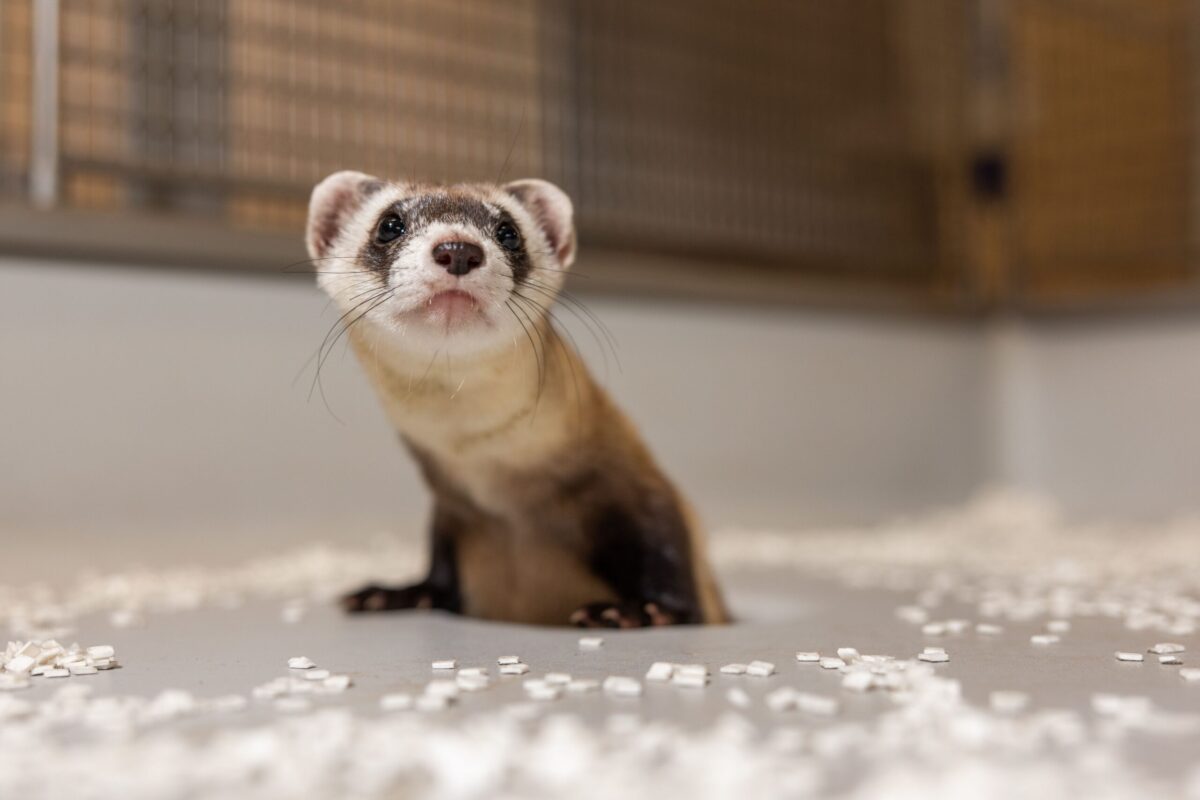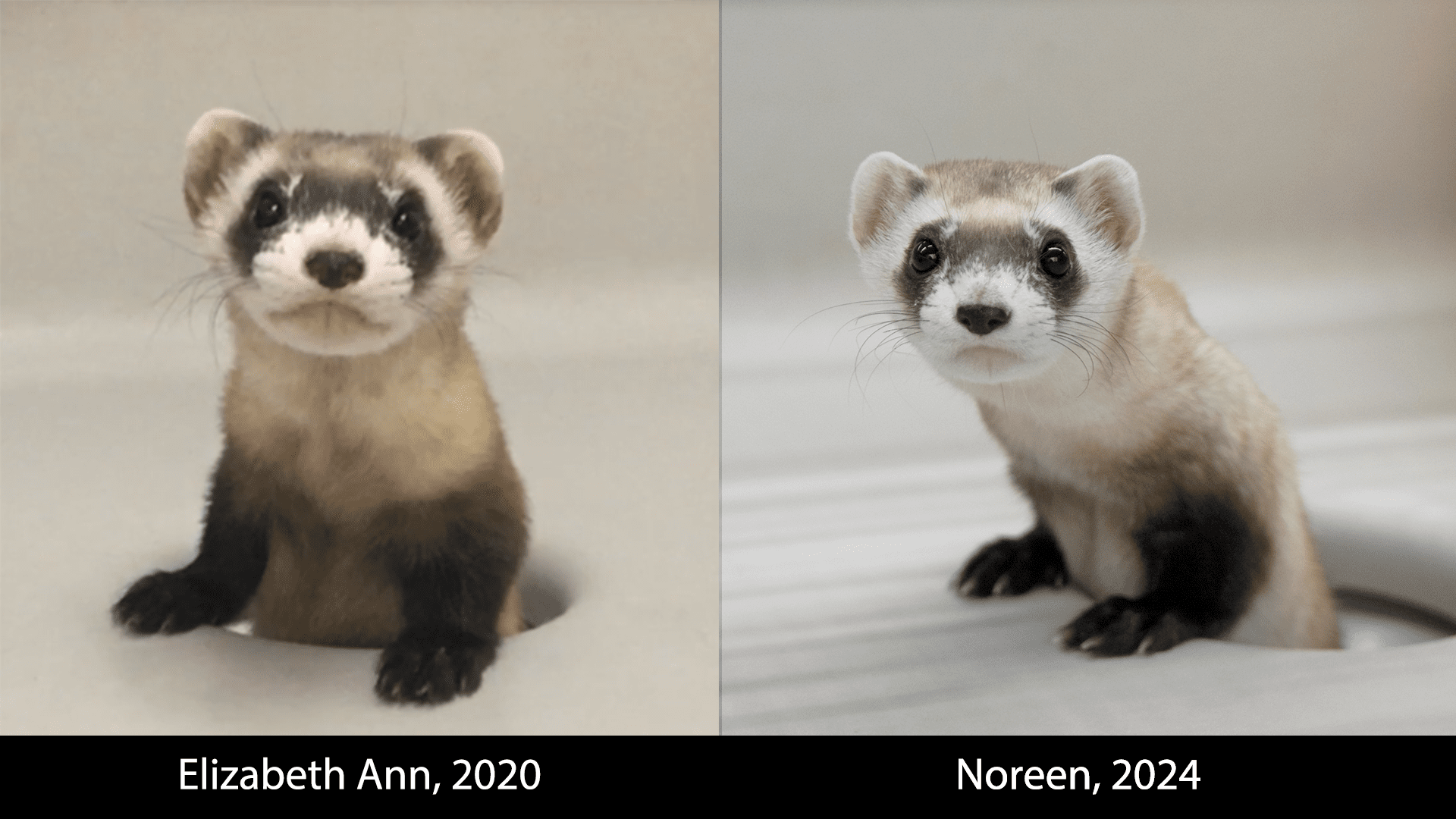USFWS, Revive & Restore, and Partners Announce Continued Success in Cloning Research to Further Black-footed Ferret Conservation Efforts
DENVER, CO / April 17, 2024 — Today, the U.S. Fish and Wildlife Service and its genetic research partners announce the birth of two new black-footed ferret clones – known as Noreen and Antonia – and are providing an update on their latest efforts to breed previously cloned black-footed ferret, Elizabeth Ann.
Noreen was born at the National Black-footed Ferret Conservation Center, while Antonia resides at the Smithsonian’s National Zoo & Conservation Biology Institute in Virginia. Both were cloned from the same genetic material as Elizabeth Ann. They are healthy and continue to reach expected developmental and behavioral milestones. The Service and its research partners plan to proceed with breeding efforts for Noreen and Antonia once they reach reproductive maturity later this year.
This scientific advancement to clone the first U.S. endangered species is the result of an innovative partnership among the Service and critical species recovery partners and scientists at Revive & Restore, ViaGen Pets & Equine, Smithsonian’s National Zoo and Conservation Biology Institute, San Diego Zoo Wildlife Alliance, and the Association of Zoos and Aquariums. The application of this technology to endangered species addresses specific genetic diversity and disease concerns associated with black-footed ferrets. The Service views this new potential tool as one of many strategies to aid species recovery alongside efforts to address habitat challenges and other barriers to recovery.
Elizabeth Ann remains healthy at the National Black-footed Ferret Conservation Center in northern Colorado, exhibiting typical adult ferret behavior. Planned efforts to breed Elizabeth Ann were unsuccessful due to a condition called hydrometra, where the uterine horn fills with fluid. Her other uterine horn was not fully developed, which is not unusual in other black-footed ferrets and therefore not believed to be linked to cloning. Elizabeth Ann otherwise remains in excellent health, symbolizing the early progress in biotechnology for species conservation.
Elizabeth Ann, Noreen and Antonia were cloned from tissue samples collected in 1988 from a black-footed ferret known as Willa and stored at San Diego Zoo Wildlife Alliance’s Frozen Zoo. These samples contain three times more unique genetic variations than found on average in the current population. Introducing these currently unrepresented genes into the existing population would significantly benefit the species’ genetic diversity.
All black-footed ferrets alive today, except the three clones, are descendants of the last seven wild individuals. This limited genetic diversity leads to unique challenges for their recovery. Besides genetic bottleneck issues, diseases like sylvatic plague and canine distemper further complicate recovery efforts. Cloning and related genetic research could offer potential solutions, aiding concurrent work on habitat conservation and reintroducing black-footed ferrets into the wild.
Ongoing collaboration with innovative partners is driving scientific progress, underscoring the crucial role of conservation partnerships in safeguarding and improving American biodiversity. The Service will continue to provide updates as the research progresses. This research does not in any way supplant or diminish the Service’s efforts to recover the species in the wild. Those efforts, including reintroduction and monitoring of extant populations across the Great Plains, are ongoing, and the Service continues to collaborate with many partners working to conserve habitat for the species.
Cloned black-footed ferret, Noreen, hides in her “burrow” at the National Black-Footed Ferret Conservation Center | Kika Tuff, Revive & Restore
About the U.S. Fish and Wildlife Service
The U.S. Fish and Wildlife Service works with others to conserve, protect, and enhance fish, wildlife, plants, and their habitats for the continuing benefit of the American people. For more information, visit www.fws.gov and connect with us on social media.
About Revive & Restore
Revive & Restore is the leading wildlife conservation organization promoting the incorporation of biotechnologies into standard conservation practice. The Sausalito, California nonprofit was formed in 2012 with the idea that 21st century biotechnology can and should be used to enhance genetic diversity, build disease resistance, and facilitate adaptation. Its mission is to enhance biodiversity through the genetic rescue of endangered and extinct species.
About ViaGen Pets & Equine
ViaGen Pets and Equine is the worldwide leader in cloning the animals we love. For over 20 years, we have been committed to the health and well-being of every animal we work with. Our team includes leading scientists, and we believe that moving the promising and exciting area of animal genetic research forward will benefit all animals.
About the San Diego Zoo Wildlife Alliance
The San Diego Zoo Wildlife Alliance is a nonprofit international conservation leader, committed to inspiring a passion for nature and working toward a world where all life thrives. The Alliance empowers people from around the globe to support their mission to conserve wildlife through innovation and partnerships. San Diego Zoo Wildlife Alliance supports cutting–edge conservation and brings the stories of their work back to the San Diego Zoo and San Diego Zoo Safari Park—giving millions of guests, in person and virtually, the opportunity to experience conservation in action.
About the Smithsonian’s National Zoo and Conservation Biology Institute
The Smithsonian’s National Zoo and Conservation Biology Institute (NZCBI) leads the Smithsonian’s global effort to save species, better understand ecosystems and train future generations of conservationists. Its two campuses are home to some of the world’s most critically endangered species. Always free of charge, the Zoo’s 163-acre park in the heart of Washington, D.C., features 2,100 animals representing 400 species and is a popular destination for children and families. At the Conservation Biology Institute’s 3,200-acre campus in Virginia, breeding and veterinary research on 250 animals representing 20 species provide critical data for the management of animals in human care and valuable insights for conservation of wild populations. NZCBI’s more than 300 staff and scientists work in Washington, D.C., Virginia and with partners at field sites across the United States and in more than 30 countries to save wildlife, collaborate with communities and conserve native habitats. NZCBI is a long-standing accredited member of the Association of Zoos and Aquariums.
About the Association of Zoos and Aquariums
The Association of Zoos and Aquariums (AZA), founded in 1924, is a nonprofit organization dedicated to the advancement of zoos and aquariums in the areas of conservation, animal wellbeing, education, science, and recreation. AZA is the accrediting body for the top zoos and aquariums in the United States and 12 other countries. Look for the AZA accreditation logo whenever you visit a zoo or aquarium as your assurance that you are supporting a facility dedicated to providing excellent care for animals, a great experience for you, and a better future for all living things. The AZA is a leader in saving species and your connection to helping animals all over the world.
More posts in News & Media










